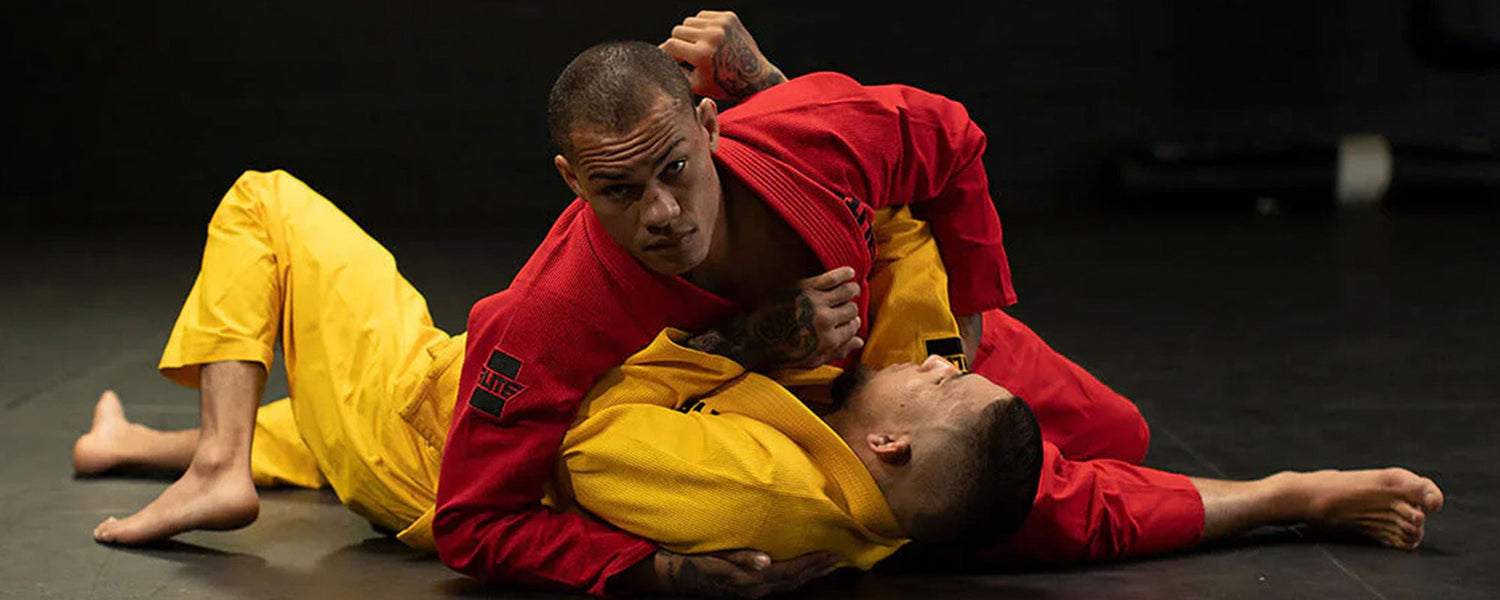Table of content

Beginning BJJ is one of the healthiest decisions you can ever make.
To get started, you should learn the basic positions that are going to be all that the game revolves around.
Both opponents in a BJJ fight are always going for the best position because it awards points and gives you leverage to execute submissions.
While a beginner who’s seen BJJ in MMA fights might think it’s all about submission holds, athletes focus on attaining and sustaining positions.
To help understand the importance of sustaining a position, one only needs to read the scoring rules of any BJJ competition.
These rules clearly state that for any position to count as a legitimate score, clear control must be shown for at least 3 seconds.
The same principle is applied to takedowns and throws.
If you can’t sustain yourself after executing a sweep or takedown, or if your opponent escapes your mount, you don’t get any points.
1. Mount
The mount position is an advantageous position if you can hold it.
Though most see it as a win, it’s just as easy to lose this position and be locked in a submission.
Allowing you to go for submissions and positions like the high mount to score additional points, the mount itself gives you 4 points. (Find the score guide below!)
1.1. How to get into the Mount?
A position is considered a legitimate mount when the person on top straddles and kneels over the person on the ground.
You can get into a mount after reversals, takedowns, sweeps and passes.
There are no limitations that define how you can get into it, just like there’s no limitation to what you can do once you get a mount.
2.2. Advantages of the Mount Position:
- The mount is clearly the most dominant position in BJJ as it gets you the highest points.
- Additionally, a mount gives you access to your opponent’s arms and neck, especially when they’re trying to escape the mount.
- This can be deadly for the person stuck in a mount, and the perfect opportunity for the one who has the mount.
Also read: TOP SUBMISSIONS IN BJJ
2. Rear Mount / Back Control
The rear mount is perhaps the staple of BJJ as almost everyone recognizes the superior control BJJ athletes have in the position.
Holding your opponent from the back with your legs wrapped around them is known as a rear mount and is the absolute winning position.
2.1. How to get into the Rear Mount Position?
You can get into a rear or back mount position after sweeping your opponent, taking them down, applying a reversal, transitioning from side mount or guard, etc.
Over the history of BJJ, athletes have beaten opponents twice their sizes by getting the rear mount.
2.2. Advantages of the Rear Mount Position
- Since you’re on the opponent’s back, you have a series of advantages.
- Not only can your opponent not extend their limbs enough to reach you, but they can’t see you either.
- This means anything and everything you do will be a surprise for the opponent.
- If stuck in this situation, your primary concern should be saving your neck because that’s the endgame.
- Once the person with the rear mount hooks in their opponent’s neck, it’s game over.
- Mostly famous for providing subtle choking submission holds, rear mounts also score you 4 points for the win.
- A traditional back mount with knees on the ground and your opponent on their stomach will get you 4 points.
- If you get the hooks in, it’s an additional 4 points at that.
- For a body triangle from the back, you get 4 points as well.
3. Side Mount / Side Control
Side mount or side control is another common position you’ll see athletes assume as a result of any tussle that involved guard passes, takedowns, sweeps, etc.
Although it doesn’t carry points, side control or side mounts are achieved when the players are chest to chest but at a perpendicular angle to each other.
That is to say, the person on top needs to be pinning their opponent from the side across their chest.
3.1. How to get in a Side Mount Position?
Side mounts are most common whenever someone escapes or passes a guard or achieves a sweep.
Your primary goal as a BJJ athlete stuck in someone’s guard is to pass it and get to side control.
From there on, the practitioner can transition to favorable positions or even go for submissions.
3.2. Advantages
- The side mount gives you control of your opponent’s movements.
- Provided that you can hook it right, it can even grant you a submission hold for the win.
- Though it’s mostly the go-to position for whenever you pass the guard, achieving side control is possible in several other scenarios.
- The most dominating part about side mounts is that you get complete control of your opponent’s hips, immobilizing them.
- With a hook placed beside their waist, you can move around with their escape attempts to keep them pinned before moving to your favored position.
4. Turtle
As weak as the turtle might seem, like all BJJ positions, it has its own significant advantages.
Not only is it one of the best defenses, but it also serves as a recovery position for the times you can’t score a side mount or lose your guard.
Firstly, let’s look at how you get into this position:
4.1. How to get into the Turtle Position?
With your head tucked in, put it down along with your hands and knees on the ground.
It’s important that your heels are facing upward and your toes are bent.
Moreover, your head needs to be close to your chest or you’ll be giving your neck away for a submission hold.
4.2. Advantages of the Turtle
- Though it seems like a position of submission from many cultures, it’s actually an effective defense strategy that can leave an arrogant and unaware opponent on their backs in BJJ.
- Given the right opportunity and applied technique, it can even grant you a submission hold that can guarantee victory.
- This is why defending and attacking the turtle should be done very carefully.
- It’s no wonder the match becomes critically more suspenseful when a player assumes the turtle position.
- If the attacker doesn’t undo the turtle right, they’re going to leave themselves open to armlocks, takedowns, knee on belly, side mounts, etc.
Also read: TOP 5 SWEEPS FOR BJJ BEGINNERS
5. Knee on Belly
Knee on belly is not that hard to understand as the name completely illustrates the scenario.
Having your knee on your opponent’s belly who’s down on the ground is considered a win.
5.1. How to Get into the Knee on Belly Position?
After a sweep, takedown, guard pass or even a failed submission, you can land your knee on your opponent’s belly.
However, a careful fact to be considered is that you need to have your other leg far from your opponent’s body.
Otherwise, you won’t have enough leverage to exert pressure on the stomach and they can easily pin your leg to take you down on your back.
5.2. Advantages of Knee on Belly Position:
- Not only does this block your opponent’s stomach and prevents breathing, but it also inflicts pain. Additionally, it also leaves them open to more submissions.
- That is why you get 2 points in a BJJ match for getting into this position.
- Having little escapes, the knee on belly position allows the athlete on top to go for a series of armlocks.
- If smart players see through those submission holds, they might leave themselves open for a rear mount as well.
- It’s important that you learn how to use and escape the knee on belly position.
6. More Positions
There are more positions such as the guard.
In BJJ, a guard is a defensive stance that has a lot of types and further techniques as well as escapes or guard passes.
Other than this, you should also learn about the basic movements in BJJ such as bridging, shrimping, sweeps and transitions.
6.1. How Do Positions Get Scored in BJJ?
Here’s a scoring guide along with major rules followed in most BJJ competitions.












Leave a comment
This site is protected by hCaptcha and the hCaptcha Privacy Policy and Terms of Service apply.